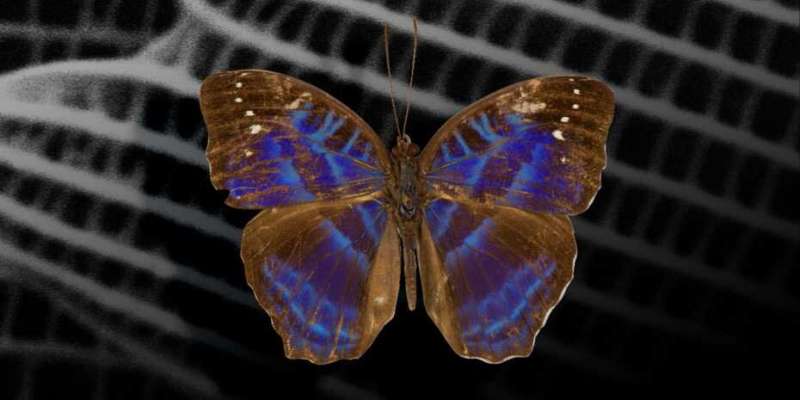
ETH Zurich researchers have created artificial colors by 3D printing certain nanostructures inspired by those of a butterfly. This principle can be used in the future to produce color screens.
For their new technology, scientists in the group of Andrew deMello, Professor of Biochemical Engineering, drew inspiration from butterflies. The wings of the species Cynandra opis, native to tropical Africa, are decorated with brilliant colors. These are produced by extremely intricate regular surface structures in the size range of the wavelength of visible light. By deflecting light rays, these structures either amplify or cancel out individual color components of the light. Led by deMello, the researchers have succeeded in replicating the surface structures of Cynandra opis, as well as other modified structures, using a nano-3D printing technique. In this way, they created an easy-to-use principle for the production of structures that generate structural colors.
There are numerous examples of such structural colouration in nature, including irregular surface structures—for example, found in other butterfly species. “The regular nanostructures on the wings of Cynandra opis, however, were particularly well suited to reconstruction using 3D printing,” explains Xiaobao Cao, a former doctoral student of the deMello group and lead author of this study. The Cynandra opis structures consist of two grid layers stacked perpendicular to each other, with a lattice spacing of about 1/2 to 1 micrometer.
Entire color palette
By varying this lattice spacing and the height of the lattice rods in the range between 250 nanometres and 1.2 micrometers, the ETH researchers were able to produce 3D printed structures that generate all the colors of the visible spectrum. Many of these colors do not occur in the natural model (the butterfly) their structures are based on.
The researchers succeeded in producing such surfaces using different materials, including a transparent polymer. “This made it possible to illuminate the structure from behind to bring out the color,” explains Stavros Stavrakis, a senior scientist in deMello group and co-author of the study. “This is the first time we’ve managed to produce all the colors of the visible spectrum as structural colors in a translucent material.”
Security feature
As part of the study, the scientists produced a miniature image of multi-hued structural-color pixels measuring 2 by 2 micrometers. Such tiny images could one day be used as a security feature on banknotes and other documents. Because the colors can be produced with transparent material, it would also be possible to manufacture color filters for optical technologies. This fits well with the main research activity of ETH Professor deMello’s group, which develops microfluidic systems—miniaturized systems for chemical and biological experiments.
Large-scale production of nanostructures is also conceivable, the researchers say. A negative structure could be 3D printed to serve as a template, which would make it possible to produce large numbers of reproductions. This means the principle could be suitable for the manufacture of high‑resolution color displays, such as thin bendable screens. And finally, the scientists point out that structural colors could replace the pigments used today in printing and painting. Structural colors have certain advantages over conventional pigments: they last longer because they do not fade when exposed to light, and in most cases they have a better environmental footprint.
The research was published in Advanced Materials.
More information:
Xiaobao Cao et al, Replicating the Cynandra opis Butterfly’s Structural Color for Bioinspired Bigrating Color Filters, Advanced Materials (2022). DOI: 10.1002/adma.202109161
Journal information:Advanced Materials
Provided by
ETH Zurich

READ MORE
Team creates micro-robots propelled by air bubbles and ultrasound
A scanning electron microscope image shows a cell-size robotic swimmer that can be powered and [...]
Solitonics in molecular wires could benefit electronics
Chemical structure of polymethine – the polyacetylene molecules considered in this work. Corresponding Kohn−Sham orbital [...]
March 10 Birthday Astrology
The astrological symbol for Pisces, the twelfth sign of the year, is the Fish. Numerology [...]
Surprise physics in insulating material offer path for faster tech
Photoinduced structural change and insulator-to-metal transition. a, Top left, schematic representation of an epitaxially strained [...]
Is eyebrow tinting right for me?
Eyebrow tinting can makes your eyes pop, but make sure you do your research before [...]
Scientists develop an approach to predict the properties of nanomaterials
A graphic abstract of the approach to develop a model for predicting the photocatalytic properties [...]
Meet the Ocelot: The Cutest Little Big Cat
In the 1960s and ’70s, the ocelot was the spotted cat most heavily exploited by [...]
This Guy Got Himself Stung 1,000 Times For Science—Here’s What He Learned
Entomologist Justin O. Schmidt holds the notorious tarantula hawk, one of the only creatures to [...]